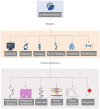Advances in artificial intelligence for the diagnosis and treatment of ovarian cancer (Review)
- PMID: 38240090
- PMCID: PMC10828921
- DOI: 10.3892/or.2024.8705
Advances in artificial intelligence for the diagnosis and treatment of ovarian cancer (Review)
Abstract
Artificial intelligence (AI) has emerged as a crucial technique for extracting high‑throughput information from various sources, including medical images, pathological images, and genomics, transcriptomics, proteomics and metabolomics data. AI has been widely used in the field of diagnosis, for the differentiation of benign and malignant ovarian cancer (OC), and for prognostic assessment, with favorable results. Notably, AI‑based radiomics has proven to be a non‑invasive, convenient and economical approach, making it an essential asset in a gynecological setting. The present study reviews the application of AI in the diagnosis, differentiation and prognostic assessment of OC. It is suggested that AI‑based multi‑omics studies have the potential to improve the diagnostic and prognostic predictive ability in patients with OC, thereby facilitating the realization of precision medicine.
Keywords: artificial intelligence; ovarian cancer; radiomics; whole‑slide imaging.
Conflict of interest statement
The authors declare that they have no competing interests.
Figures



References
-
- Allemani C, Weir HK, Carreira H, Harewood R, Spika D, Wang XS, Bannon F, Ahn JV, Johnson CJ, Bonaventure A, et al. Global surveillance of cancer survival 1995–2009: Analysis of individual data for 25,676,887 patients from 279 population-based registries in 67 countries (CONCORD-2) Lancet. 2015;385:977–1010. doi: 10.1016/S0140-6736(14)62038-9. - DOI - PMC - PubMed
Publication types
MeSH terms
LinkOut - more resources
Full Text Sources
Medical

